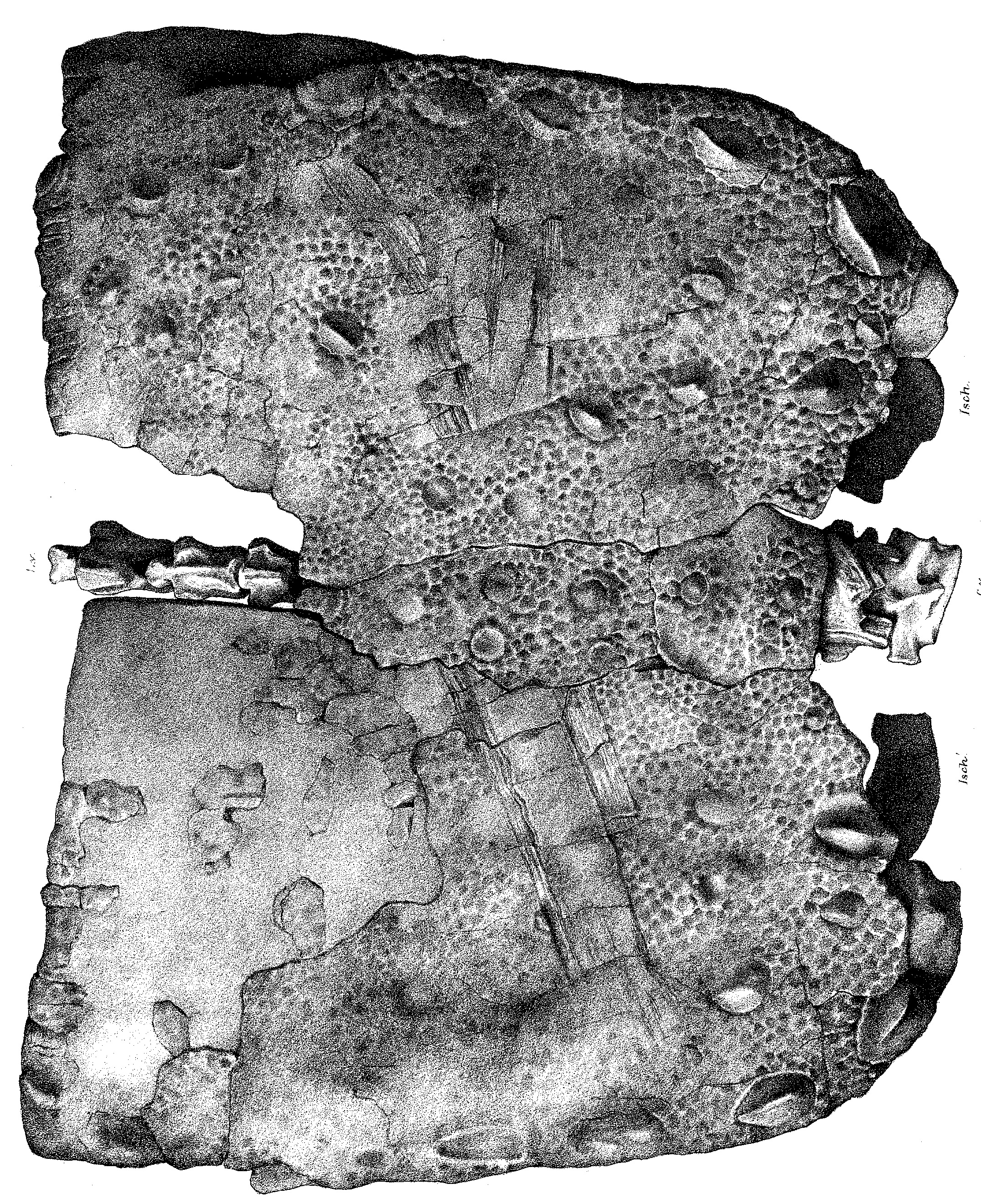- Polacanthus
Taxobox
name = "Polacanthus"
fossil_range =Early Cretaceous

image_width = 200px
image_caption = Armour of "Polacanthus foxii"
regnum =Animal ia
phylum = Chordata
classis = Sauropsida
superordo =Dinosaur ia
ordo =Ornithischia
subordo =Thyreophora
infraordo =Ankylosauria
familia =Ankylosaurid ae
subfamilia = Polacanthinae
genus = "Polacanthus"
genus_authority = Owen "vide" Anonymous, 1865 [Genus authority given as Huxley, 1867 in some sources, such as the second edition of "The Dinosauria".]
subdivision_ranks=Species
subdivision=
*"P. foxii" Owen "vide" Anonymous, 1865 [Species authority given as Hulke, 1881 in some sources, such as the second edition of "The Dinosauria".] (type)
*"P. rudgwickensis" Blows, 1996"Polacanthus", deriving its name from the
Ancient Greek poly-/πολυ- "many" and acantha/ακανθα "thorn" or "prickle", [cite book|author=Liddell & Scott|year=1980|title=Greek-English Lexicon, Abridged Edition |publisher=Oxford University Press, Oxford, UK|id=ISBN 0-19-910207-4] was an early armored, spiked, plant-eatingankylosaur from the earlyCretaceous period. It lived 132 to 112 million years ago in what is now westernEurope .Description
"Polacanthus" grew to between 4 and 5 meters long. It was a
quadruped alornithischian or "bird-hipped" dinosaur. There are not manyfossil remains of this creature, and some important anatomical features, such as its skull, are poorly known."Polacanthus" had a large sacral shield, a single fused sheet of dermal bone over its hips (sacral area) which was not attached to the underlying bone and decorated with tubercles. This feature is shared with other Polacanthine dinosaurs such as "Gastonia" and "
Mymoorapelta ".Discovery and species
The genus "Polacanthus" comprises two species from Europe:
* "Polacanthus foxii" was discovered by the Reverend William Fox on theIsle of Wight in 1865. [Fox W. (1865). On a new Wealden saurian named "Polacanthus". "Report of the British Association for the Advancement of Science", 1865 for 1864, p. 56] It was an incomplete skeleton with the head, neck, anterior armour and forelimbs missing. Two other partial skeletons have since been found. The second known specimen was found and excavated by Dr William T. Blows in 1979, and is also in the LondonNatural History Museum . It is the first specimen to show neck vertebrae and anterior armour. [Blows WT. (1987). The armoured dinosaur "Polacanthus foxi", from the Lower Cretaceous of theIsle of Wight , Palaeontology. 30, 557–580]*"P. rudgwickensis" was named in 1996 by Dr. William T. Blows, [Blows WT (1996) A new species of "Polacanthus" (Ornithischia; Ankylosauria) from the Lower Cretaceous of Sussex, England. Geological Magazine, 133 (6): 671-682] after review of some fossil material found in 1985 and thought to have been "
Iguanodon ", which was on display at the Horsham Museum inSussex . The material is fragmentary and includes several incompletevertebrae , partial scapulocoracoid, thedistal end ofhumerus , a nearly complete righttibia , rib fragments, and twoosteoderms . "P. rudgwickensis" seems to have been about 30% larger than type species "P. foxii" and differs from it in numerous characters of the vertebrae anddermal armor. It is named after the village of Rudgwick inWest Sussex and was discovered at a Rudgwick Brickworks Company quarry, at the quarry floor in gray-greenmarl beds of the Wessex Formation.Barremian age, approximately 124-132 million years ago.Popular culture
Despite its dramatic appearance, "Polacanthus" is not often depicted in popular culture. However, it did appear on the fourth episode of "
Walking with Dinosaurs ", but only for a brief time. It and "Iguanodon " are said to travel together.A "Polacanthus" also makes a brief appearance in the 1975 film "The Land That Time Forgot".Early depictions often gave it a very vague head as it was only known from the rear half of the creature."Polacanthus" bones can be seen in
Bexhill museum inEast Sussex , and Horsham museum in West Sussex.On the TV show "Dinosaurs", Robbie's friend Spike was a "Polacanthus".
In the 1978 movie "
Planet of Dinosaurs ", a "Polacanthus" is used as bait against a "Tyrannosaurus ".References
*
*
External links
* [http://www.bexhill-museum.co.uk/index.asp Bexhill Museum]
* [http://www.horshammuseum.org/ Horsham Museum]
* [http://www.blowsesq.org.uk/ William T. Blows] (Describer of second "Polacanthus" species)
Wikimedia Foundation. 2010.
